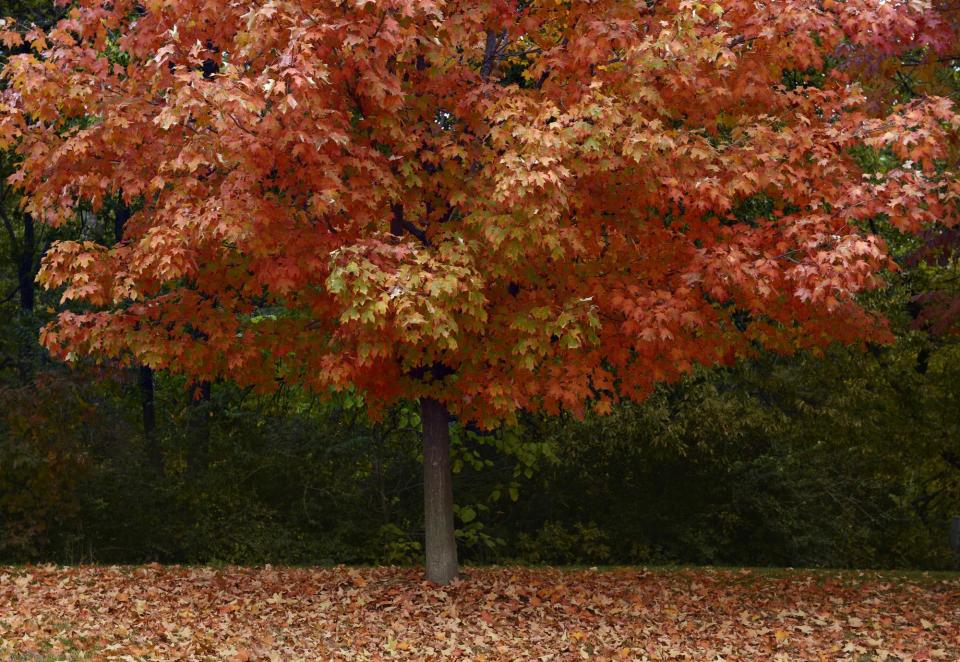Fall foliage in Illinois: When will leaves change color? Here are peak times, best locations
PEORIA— The Illinois Office of Tourism and state Department of Natural Resources have set up a Fall Colors Trip Planner that helps identify the best place to look at the fall foliage.
The new online guide features an interactive state map that allows people to track fall colors by region within a specific time frame throughout the season.
The best viewing for fall foliage in northern Illinois is in the second week of October. Peak viewing in central Illinois is the middle of October. Southern Illinois' peak viewing time is the end of October.
Fall foliage viewing in Illinois
The state also has planned a variety of fall travel trip itineraries created to highlight must-visit sights and attractions that are unique to Illinois.
One such trip is dubbed Great Pumpkin Country and includes viewing spots in Arthur in a pumpkin patch as well as a stop to pick apples at Curtis Orchard and a visit to the state’s only dark sky park, both located in Champaign.
Another trip, dubbed "Frights and Delights in Illinois," is based in southeastern Illinois cities such as Alton and Edwardsville. The trip planner says to check out Pere Marquette State Park, where fall foliage should be peaking around late October, just in time for Halloween.
The state fall planner doesn't highlight anything in the Peoria area.
Where is the best place to see fall colors in Peoria?
So, where and when is the best time to travel about the state to see nature at its finest? It depends.
Illinois is at its peak for fall foliage in October and the farther north you are, the earlier the leaves turn.
The Peoria area offers many choices for people, said Mike Miller, the Peoria Park District's supervisor of environmental services. For those who want a scenic drive, there's the Illinois River Road, a national scenic byway that follows the river from Ottawa to Havana. Driving along Illinois Route 29 on the Peoria side or Illinois Route 26 on the Tazewell and Woodford county side is another option.
Of course, there's also Grandview Drive, which overlooks the valley. There are benches that look out over the river or, Miller said, there's a "pretty rugged" 1.25-mile trail from the park down to Forest Park Nature Center, where an easier and more level trail can get people into a wooded area for optimal viewing.
Other areas around Peoria that offer up good foliage are Wildlife Prairie Park, Kinsey Park and Jubilee College State Park, all located just west of the city. But when is a good time go? That's the tough part.
"Predicting fall colors is a bit like saying it's going to rain three months from now on a Wednesday," he joked. "I think that as we have had a fairly normal season of rainfall and if we get some cool nights and warm days, we'll have a good season. It tends to peak here around the week of Oct. 15 to 20."
But he also said to go out and explore, because, as he put it, "there are never horrible fall colors. Just different degrees."
Where the fall colors burn brightestHere are prime spots for Peoria-area leaf peepers
Leaf science
Several factors influence why some trees turn a bright shade of orange or red before others. The U.S. Forest Service has a website that attempts to break that down, but in a nutshell, it's the weather and how long nights become.
Temperature is one factor, but it's the "steadily increasing length of night during autumn" that plays a major role.
"As days grow shorter, and nights grow longer and cooler, biochemical processes in the leaf begin to paint the landscape with Nature's autumn palette," the forest service said on its website.
As the days get longer and the nights grow colder, plants stop producing as much chlorophyll, which is the chemical that is necessary for photosynthesis but also one that keeps the leaves green. Other chemicals within the plant that make yellow and red hues, carotenoids and anthocyanin, continue to be produced.
"In early autumn, in response to the shortening days and declining intensity of sunlight, leaves begin the processes leading up to their fall. The veins that carry fluids into and out of the leaf gradually close off as a layer of cells forms at the base of each leaf. These clogged veins trap sugars in the leaf and promote production of anthocyanin. Once this separation layer is complete and the connecting tissues are sealed off, the leaf is ready to fall," the forest service website stated.

This article originally appeared on Journal Star: Want to see great fall colors in Illinois? Here's a guide

